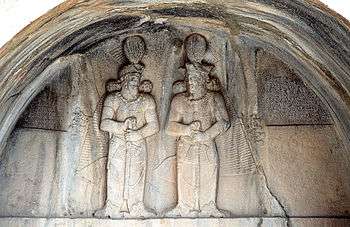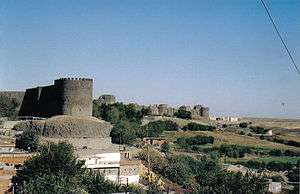Siege of Amida
| Siege of Amida | |||||||||
|---|---|---|---|---|---|---|---|---|---|
| Part of the Roman-Persian Wars | |||||||||
 Shapur II, conqueror of Amida, along with Shapur III | |||||||||
| |||||||||
| Belligerents | |||||||||
| Eastern Roman Empire | Sassanid Empire | ||||||||
| Commanders and leaders | |||||||||
|
Count Aelianus †[1] Sabinianus Ursicinus |
Shapur II Grumbates Antoninus Urnayr | ||||||||
| Strength | |||||||||
|
Legio V Parthica (garrison force) Legio XXX Ulpia Legio X Fretensis Superventores, Praeventores Comites Sagittarii (Household mounted archers) Legions from Gaul loyal to Magnentius |
Sassanid army Xionites Gelani Albani Segestani | ||||||||
| Casualties and losses | |||||||||
| Most defenders, some citizens, some refugees from countryside[2] | circa 30,000 Persian dead[3] | ||||||||
The Siege of Amida took place when the Sassanids, under Shah (king) Shapur II besieged the Roman city of Amida in 359.
In this battle Ammianus Marcellinus, a historian of Greek origin from Antioch, was a Roman army officer; he described the siege in his work (Res Gestae).
Background
Persian
When Shapur II took control of the Sassanid Empire he sought to regain old territories previously lost to the Roman Empire. After crushing the Arabs in the south, he moved east to deal with nomadic forces, the most prominent being the Xionites.[4] Following a prolonged struggle from (353-358) the Xionites were forced to conclude a peace, and their king, Grumbates, accompanied Shapur II in the war against the Romans.[5][6] In 358 the Romans had failed to dissuade Shapur from attacking Mesopotamia, so the next year Shapur decided to invade.[7] Shapur started the western campaign in 359.
Roman
Emperor Constantius II had increasingly been doubting the loyalty of general Ursicinus. As a result, he did not give him command of the Roman forces in the East, and instead gave it to Sabinianus. As news of the Persian invasion spread, the civilian population of the region began to panic:
"Dispatch riders were sent at once to Cassian, the general of Mesopotamiam and Euphronius, then governor of the province, with orders to compel the country folk [farmers] to move with their families and all their livestock to places of safety. Carrhae was to be evacuated immediately, because of the weakness of its fortifications, and the whole country set on fire (see:scorched earth), to deprive the enemy of a source of fodder."— Ammianus Marcellinus, Res Gestae, 18.7
In the panic which followed, several Roman legions chaotically escaped the Persian advance to the safety of Amida. These included the Legio XXX Ulpia Victrix and the Legio X Fretensis.
Preliminaries of the siege
It appears the Sassanid plan was to bypass difficult fortresses like Nisibis and to then march straight into Syria. When his forces approached Amida, the Sassanids were provoked into attacking the city.[8] This came about when the son of Grumbates, while inspecting the defences of Amida, was shot and killed with an arrow shot by the city garrison.[9] Ammianus described how the Grumbates, outraged at his son's death, demanded revenge from the Romans: he compares the death to that of Patroclus at Troy. The Sassanids began the attack with siege towers and attempted to take the city hastily, but were largely unsuccessful. Unable to gain a quick victory, Shapur had to commit to capturing Amida in order to appease his ally.
Siege

According to Ammianus Marcellinus
The king himself [Shapur II], mounted upon a charger and overtopping the others, rode before the whole army, wearing in place of a diadem a golden image of a ram's head set with precious stones, distinguished too by a great retinue of men of the highest rank and of various nations. But it was clear that he would merely try the effect of a conference on the defenders of the walls, since by the advice of Antoninus he was in haste to go elsewhere.
He continues with the account of how he reached the safety of the city just as the Sassanids were descending on the city:
I myself, having taken a direction apart from that of my comrades, was looking around to see what to do, when Verennianus, one of the guard, came up with an arrow in his thigh; and while at the earnest request of my colleague I was trying to pull it out, finding myself surrounded on all sides by the advancing Persians, I made up for the delay by breathless speed and aimed for the city, which from the point where we were attacked lay high up and could be approached only by a single very narrow ascent ; and this was made still narrower by mills which had been built on the cliffs for the purpose of making the paths. Here, mingled with the Persians, who were rushing to the higher ground with the same effort as ourselves, we remained motionless until sunrise of the next day, so crowded together that the bodies of the slain, held upright by the throng, could nowhere find room to fall, and that in front of me a soldier with his head cut in two, and split into equal halves by a powerful sword stroke, was so pressed on all sides that he stood erect like a stump.
The siege took 73 days. Shapur attempted to capture the city several times but every time it ended with disaster. Many times siege towers were set on fire by the Romans. During the siege, plague broke out in Amida but ended after ten days by a light rain. A day before capture of the city, Ammianus Marcellinus escaped to Melitene, and thence returned to Antioch.
Outcome
After capturing the city, the garrison and its inhabitants were put to the sword. The Persians lost approximately 30,000 in the siege but Shapur II advanced further and took Singara and some other fortresses in the following years. In 363, Emperor Julian, at the head of a strong army, advanced to Ctesiphon but was killed in battle. His successor Jovian signed a treaty of peace, by which the districts on the Tigris and Nisibis (totalling five Roman provinces) were ceded to the Persians and the Romans promised to interfere no more in Armenia.
References
- ↑ Ammianus Marcellinus (1982). Res Gestae. Cambridge, MA: Harvard University Press. pp. 18.8.2.
- ↑ Ammianus Marcellinus. Res Gestae. pp. 19.9.9.
- ↑ Ammianus Marcellinus. Res Gestae. pp. 19.9.9.
- ↑ Ammianus Marcellinus (1982). Res Gestae. Cambridge, MA: Harvard University Press. pp. 16.9.4.
- ↑ Ammianus Marcellinus (1982). Res Gestae. Cambridge MA: Harvard University Press. pp. 18.8.2.
- ↑ Sassanian Iran- economy, society, arts and crafts, N.N.Chegini and A.V. Nikitin, History of Civilizations of Central Asia: The crossroads of civilizations, (UNESCO, 1996), 38.
- ↑ Blockley, R. C. (Autumn 1988). "Ammianus Marcellinus on the Persian invasion of A.D. 359". Phoenix. 42 (3): 244–260. doi:10.2307/1088346.
- ↑ Blockley, R. C. (Autumn 1988). "Ammianus Marcellinus on the Persian invasion of A.D. 359". Phoenix. 42 (3): 244–260. doi:10.2307/1088346.
- ↑ Ammianus Marcellinus. Res Gestae. pp. 19.1.7.
Sources
- Ammianus Marcellinus, Res Gestae (translated by J. C. Rolfe), Cambridge MA, 1982.
- Abd al-Husayn Zarrin’kub, Ruzgaran: tarikh-i Iran az aghz ta saqut saltnat Pahlvi, Sukhan, 1999. ISBN 964-6961-11-8
External links
Coordinates: 37°55′N 40°13′E / 37.917°N 40.217°E